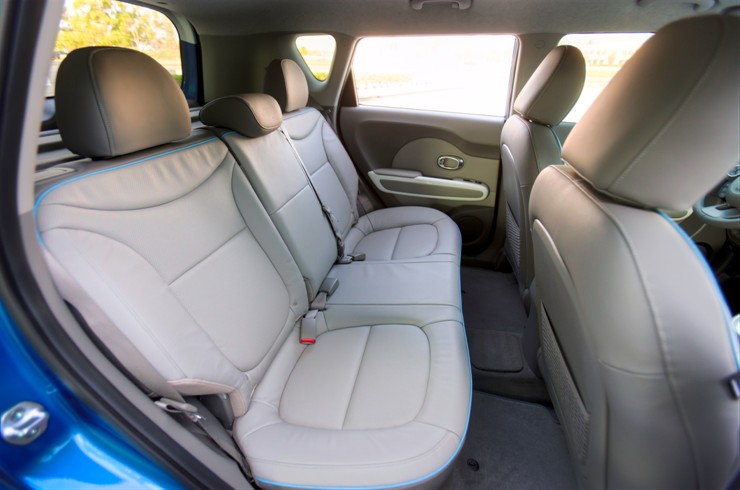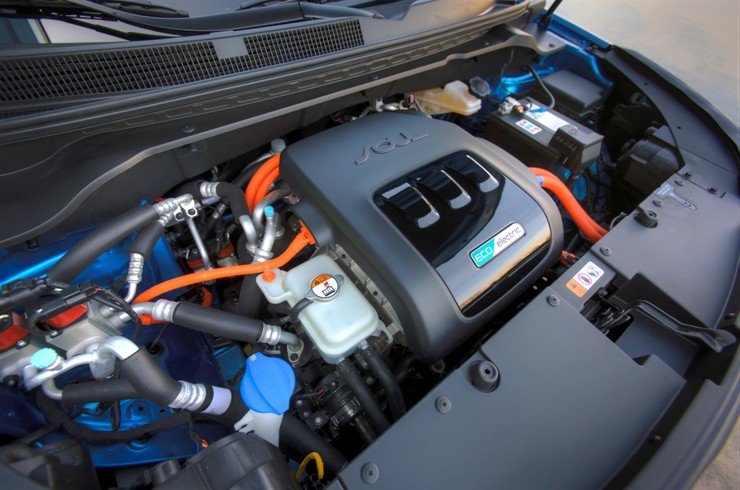
It was a cold and rainy day in New York City, a thick fog ominously blanketing Manhattan in a muffling layer of grey. I had made my way into the city to spend an afternoon with the all-new 2015 Kia Soul EV, the company’s first all-electric, zero-emissions vehicle, and I was excited at the opportunity despite the Lovecraftian weather. How would the Soul, a car known as a fun, quirky, and uppity Urban Passenger Vehicle, handle the transition from piston power to electromagnetic locomotion? Would its range estimates hold true, or would anxiety creep in? How would the added battery weight affect its ability to handle Brooklyn’s dilapidated tarmac? I was about to find out.

Range
Let’s start with the #1 concern for electric vehicle buyers: range. Kia proudly proclaims an EPA estimated range rating of 93 miles with an MPGe of 92 miles highway and 120 miles city for a combined mileage of 105 miles. That pride is deserved, as it puts it second in the range department, behind only Tesla, but ahead of other competitors like the Ford Focus Electric or the Nissan Leaf. It’s a decent helping of miles, sure, but still not high enough for a prospective buyer to contemplate venturing very far outside city limits. This is not so much Kia’s fault as it is the reality of current EV technology.
Within the city however, I found that the car’s estimates were pretty much spot on. I drove from the Port Authority Bus Terminal in Manhattan to Sheepshead Bay in Brooklyn, and back to Carlstadt in New Jersey, for a roughly 45 mile trip. The car had been delivered to me with 89 miles of range, and I returned it with 43 miles left on the dial. This included two or three wide-open-throttle passes, and a fair amount of idling time, so I was impressed at the accuracy. Yes, while 93 miles isn’t as comforting as carrying around a 400 mile tankful of fossil juice, you should at least know that what you see on the dashboard really is what you get in real life.

Performance
The Soul EV carries a highly energy-dense battery that weighs 620 pounds, and is located in the floor, beneath the seats. This both lowers the center of gravity and stabilizes the cabin in potholes, contributing to a more comfortable, planted ride. The 60-volt, 192-cell, lithium-ion polymer, gel-electrolyte battery battery pack has a capacity of 27kWh, and an output of 81kW (109hp) and 210 lb.-ft. of instantaneous torque. And we need to emphasize that “instantaneous”, as this is the saving grace of otherwise seemingly underpowered electric motors. You get all your torque the second you step on the pedal, with no build-up like in a traditional combustion engine. This, coupled with the single-speed constant-ratio gear reduction unit, means you get pushed back into your seat and remain there with zero interruptions until you let off. Sure, the 0-60 times aren’t stellar, hovering around 11 seconds, but you don’t care as much because it feels fast. It’s a feeling that’s hard to describe to someone who’s spent their life driving vehicles that need to take tiny breaks between gears. But the point is that although the Soul EV is not a sports car, it definitely doesn’t feel sluggish.

Comfort and Silence
Additionally, the motor is almost completely silent. Kia explains this by saying that the “liquid-cooled AC synchronous permanent magnet motor uses multi-layer magnets to help improve efficiency and reduce the whine common to most electric vehicles.” This is important, because there’s nothing more annoying when you’re flooring it than to make a raucous; on a vehicle that outputs a little over 100hp, it’s great being able to squeeze every drop of power without alerting the entire neighbourhood that your ride is at its limits. Given the motor’s silence, all you’re left with is road noise and wind, which is kept at a minimum thanks to excellent sound-proofing.

Ride Dynamics
Turning to ride dynamics, I was impressed with how composed the Soul EV is. NYC is notorious for its potholes and otherwise disastrous road quality and I was able to ride around with minimal inconvenience. Shocks are absorbed with aplomb and poise, and a few last-second giant-hole avoidance maneuvers resulted in minimal body roll. The lower center of gravity, coupled with additional cross-bracing in the floor contributes to a 5.9 percent improvement in torsional rigidity over the gasoline-powered Soul and offers protection to the battery. Braking was firm and did not produce excessive forward pitch.

Speaking of which, the Soul offers two types of regenerative braking. In normal drive mode, letting off the gas allows the vehicle to coast normally while regenerating the battery a little bit. But in “B” mode (break mode?), the regenerative braking becomes more aggressive; taking the foot off the pedal actively slows the car down and can send back as much as 12% of its kinetic energy to the battery. This drive mode carries a tiny learning curve, but within a few miles you become accustomed to taking your foot off instead of using the brakes, which is great both for your brake pads and your range.

Charging
When you’re done riding around in the Soul EV, you have to turn your attention to charging. In this department, you have some options. There’s an SAE J1772 port for Level 1 and Level 2 AC charging, and a CHAdeMo DC fast-charging port (480v). In short, you can get up to 80% in 30 minutes with a CHAdeMo DC fast-charging port (more common in public charging stations). Then, you can fully charge in about 5 hours with the 240V and up to 24 hours in a standard 120V outlet. Yes, 24 hours is a long time and we would suggest only ever using this in a last-resort scenario. Fortunately, the UVO infotainment center in the vehicle provides you with a pretty exhaustive list of nearby charging stations, conveniently presented to you on a map; navigating to one is a simple matter of pressing on a couple of on-screen buttons. How populated this list is obviously depends on where you live, but given that the Soul EV will initially only be offered in California, you can rest assured that there will be stations aplenty.

Eco-conscience
And so now we come to the Soul EV’s raison d’être. Being environmentally friendly is why the car is being made in the first place, and Kia recognizes that this doesn’t only mean having zero-emissions from the vehicle itself, but also in the sourcing of eco-conscious parts. The Soul EV has received an industry-first automotive environmental validation by Underwriters Laboratory for its use of bio-based materials, which include 52.7 lbs. of bio-based organic content in interior plastic.
“Front and center is the use of BTX-free paint on the audio system surround, vent bezel and the floor console. Bio-based plastics derived from cellulose and sugar cane are found in many places within the cabin, including the door panels, headliner, seat trim, roof pillars and carpeting. In all, organic, bio-based materials are used in 19 different interior parts.”
This is a reality I only became aware of later on, as I was reading press materials. The point being that their use in no way seemed to compromise perceived quality in the cabin.

In Conclusion
To make the decision to buy an electric vehicle means you care enough about the environment to be willing to pay the price premium that usually comes with such a purchase. That said, in the 2015 Kia Soul EV, you get a couple helpings of fun and quality for your money. It’s a capable vehicle with a more than respectable range, brisk performance, and unexpected comfort; a silent, sober, and well-rounded ride that can provide bursts of torquey fun in a pinch. You’ll be able to move yourself and your family around town while knowing you’re doing your part to save our planet, while sacrificing very little by giving up a gas-powered car.
Prices start at $33,700, before any state or federal incentives, and will be offered in California initially, with the rest of the country coming later in 2015.










